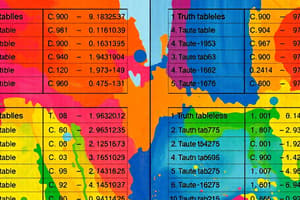Podcast
Questions and Answers
Which of the following statements is a proposition?
Which of the following statements is a proposition?
- 1 + 0 = 1 (correct)
- What time is it?
- x + 1 = 2
- Sit down!
What is the symbol for conjunction in propositional logic?
What is the symbol for conjunction in propositional logic?
- →
- ¬
- ∨
- ∧ (correct)
If proposition p is true and proposition q is false, what is the truth value of the conjunction p ∧ q?
If proposition p is true and proposition q is false, what is the truth value of the conjunction p ∧ q?
- Indeterminate
- True only under certain conditions
- False (correct)
- True
How is the negation of proposition p represented?
How is the negation of proposition p represented?
In propositional logic, what is the result of a disjunction p ∨ q if both p and q are false?
In propositional logic, what is the result of a disjunction p ∨ q if both p and q are false?
What is the main purpose of truth tables in propositional logic?
What is the main purpose of truth tables in propositional logic?
What does the implication p → q represent in propositional logic?
What does the implication p → q represent in propositional logic?
Which of the following is NOT a logical connective used in propositional logic?
Which of the following is NOT a logical connective used in propositional logic?
What is the truth value of the expression p ⊕ q when both p and q are true?
What is the truth value of the expression p ⊕ q when both p and q are true?
In the implication statement p → q, if p is false and q is true, what is the truth value of the implication?
In the implication statement p → q, if p is false and q is true, what is the truth value of the implication?
Which statement is true about the implication p → q?
Which statement is true about the implication p → q?
What can be inferred about the truth values in the statement p → q?
What can be inferred about the truth values in the statement p → q?
In the scenario where 'If it rains, then I will carry an umbrella', what is p and what is q?
In the scenario where 'If it rains, then I will carry an umbrella', what is p and what is q?
In what situation would the implication p → q be considered false?
In what situation would the implication p → q be considered false?
Which logical operation is represented by p ⊕ q?
Which logical operation is represented by p ⊕ q?
Which of the following statements about implications is true?
Which of the following statements about implications is true?
Which of the following correctly represents the negation of the proposition 'It is raining today'?
Which of the following correctly represents the negation of the proposition 'It is raining today'?
What does the conjunction of propositions p and q, denoted as p ∧ q, indicate?
What does the conjunction of propositions p and q, denoted as p ∧ q, indicate?
In logic, what is the truth value of p ∨ q when both p and q are false?
In logic, what is the truth value of p ∨ q when both p and q are false?
How does the meaning of 'or' in the statement 'Students who have taken CS202 or Math120 may take this class' differ from the meaning in 'Soup or salad comes with this meal'?
How does the meaning of 'or' in the statement 'Students who have taken CS202 or Math120 may take this class' differ from the meaning in 'Soup or salad comes with this meal'?
Which truth table correctly represents the conjunction operator (p ∧ q)?
Which truth table correctly represents the conjunction operator (p ∧ q)?
What is the correct negation of the statement '2 is a prime number'?
What is the correct negation of the statement '2 is a prime number'?
If p denotes 'I am at home' and q denotes 'It is raining', what does p ∨ q signify?
If p denotes 'I am at home' and q denotes 'It is raining', what does p ∨ q signify?
In logical terms, p ∨ q is true under which of the following conditions?
In logical terms, p ∨ q is true under which of the following conditions?
Flashcards
Propositional Variable
Propositional Variable
Letters representing propositions in a compound proposition.
Compound Proposition
Compound Proposition
A proposition formed from other propositions using logical connectives.
Proposition
Proposition
A statement that is either true or false.
Negation (¬)
Negation (¬)
Signup and view all the flashcards
Conjunction (∧)
Conjunction (∧)
Signup and view all the flashcards
Disjunction (∨)
Disjunction (∨)
Signup and view all the flashcards
Truth Table
Truth Table
Signup and view all the flashcards
Negation of a proposition
Negation of a proposition
Signup and view all the flashcards
Conjunction (p ∧ q)
Conjunction (p ∧ q)
Signup and view all the flashcards
Truth Table (Conjunction)
Truth Table (Conjunction)
Signup and view all the flashcards
Disjunction (p ∨ q)
Disjunction (p ∨ q)
Signup and view all the flashcards
Truth Table (Disjunction)
Truth Table (Disjunction)
Signup and view all the flashcards
Inclusive Or
Inclusive Or
Signup and view all the flashcards
Exclusive Or
Exclusive Or
Signup and view all the flashcards
Exclusive OR (XOR)
Exclusive OR (XOR)
Signup and view all the flashcards
Implication (Conditional)
Implication (Conditional)
Signup and view all the flashcards
Truth Table (Implication)
Truth Table (Implication)
Signup and view all the flashcards
Hypothesis
Hypothesis
Signup and view all the flashcards
Conclusion
Conclusion
Signup and view all the flashcards
Study Notes
Propositional Logic
- Propositional logic is a branch of logic that deals with propositions and their relationships.
- A proposition is a statement that is either true or false.
- Examples of propositions include:
- The moon is made of green cheese. (False)
- Makkah is the Holy City of Islam. (True)
- Madina is the capital of Saudi Arabia. (False)
- 1 + 0 = 1. (True)
- 0 + 0 = 2. (False)
- Examples that are not propositions include commands, questions, and open sentences.
- Sit down!
- What time is it?
- x + 1 = 2.
Agenda
- Agenda for the course includes:
- Propositions
- Connectives (negation, conjunction, disjunction)
- Truth Tables
Connectives
-
Negation: The negation of a proposition p is denoted by ¬p, and is read as "not p". Its truth table shows that if p is true, ¬p is false; and if p is false, ¬p is true.
-
Conjunction: The conjunction of propositions p and q is denoted by p∧q, and is read as "p and q". Its truth table shows that p∧q is only true when both p and q are true; otherwise, it is false.
-
Disjunction: The disjunction of propositions p and q is denoted by p∨q, and is read as "p or q". Its truth table shows that p∨q is true when either p or q is true, or both; it is only false when both p and q are false.
-
Inclusive or: In certain contexts "or" means at least one of p or q is true, or both are true.
-
Exclusive or: In other contexts, "or" means exactly one of p or q is true, but not both.
Truth Tables
- Truth tables list all possible values of the propositional variables in a compound proposition, showing how the compound proposition's truth value depends on the truth values of its parts. Each variable can be either True or False.
- The number of rows in a truth table with n variables is 2n.
Compound Propositions: Negation
- The negation of a proposition p is denoted by ¬p.
- Example: The earth is round. ¬p: It is not the case that the earth is round, or The earth is not round.
Compound Propositions: Conjunction
- The conjunction of propositions p and q is denoted by p∧q.
- Example: If p is "I am at home" and q is "It is raining," then p∧q is "I am at home and it is raining."
Compound Propositions: Disjunction
- The disjunction of propositions p and q is denoted by p∨q.
- Example: If p is "I am at home" and q is "It is raining," then p∨q is "I am at home or it is raining."
Exclusive Or (XOR)
- The exclusive or (XOR) of propositions p and q is denoted by p⊕q.
- One of p and q must be true, but not both.
Implication
- If p and q are propositions, then p→q is a conditional statement or implication, read as "if p, then q."
- It has a specific truth table.
- In p→q, p is the hypothesis (if-part) and q is the conclusion (then-part).
Understanding Implication
- The meaning of p→q depends only on the truth values of p and q, not on any real-world connection between them.
- Examples can be constructed that seem nonsensical in everyday language but are valid logical implications.
Different Ways of Expressing p→q
- Various ways to express the conditional implication p→q using different phrases, including "if...then," "implies," "only if".
Studying That Suits You
Use AI to generate personalized quizzes and flashcards to suit your learning preferences.




